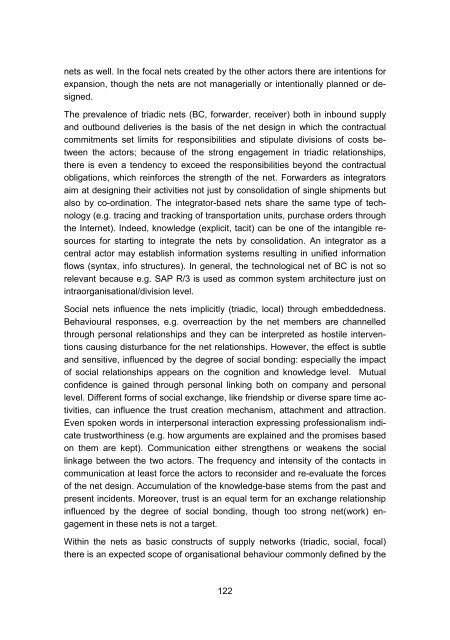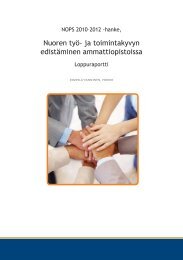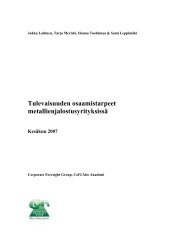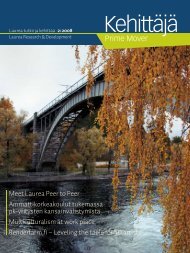849954 sisus
849954 sisus
849954 sisus
Create successful ePaper yourself
Turn your PDF publications into a flip-book with our unique Google optimized e-Paper software.
nets as well. In the focal nets created by the other actors there are intentions for<br />
expansion, though the nets are not managerially or intentionally planned or designed.<br />
The prevalence of triadic nets (BC, forwarder, receiver) both in inbound supply<br />
and outbound deliveries is the basis of the net design in which the contractual<br />
commitments set limits for responsibilities and stipulate divisions of costs between<br />
the actors; because of the strong engagement in triadic relationships,<br />
there is even a tendency to exceed the responsibilities beyond the contractual<br />
obligations, which reinforces the strength of the net. Forwarders as integrators<br />
aim at designing their activities not just by consolidation of single shipments but<br />
also by co-ordination. The integrator-based nets share the same type of technology<br />
(e.g. tracing and tracking of transportation units, purchase orders through<br />
the Internet). Indeed, knowledge (explicit, tacit) can be one of the intangible resources<br />
for starting to integrate the nets by consolidation. An integrator as a<br />
central actor may establish information systems resulting in unified information<br />
flows (syntax, info structures). In general, the technological net of BC is not so<br />
relevant because e.g. SAP R/3 is used as common system architecture just on<br />
intraorganisational/division level.<br />
Social nets influence the nets implicitly (triadic, local) through embeddedness.<br />
Behavioural responses, e.g. overreaction by the net members are channelled<br />
through personal relationships and they can be interpreted as hostile interventions<br />
causing disturbance for the net relationships. However, the effect is subtle<br />
and sensitive, influenced by the degree of social bonding: especially the impact<br />
of social relationships appears on the cognition and knowledge level. Mutual<br />
confidence is gained through personal linking both on company and personal<br />
level. Different forms of social exchange, like friendship or diverse spare time activities,<br />
can influence the trust creation mechanism, attachment and attraction.<br />
Even spoken words in interpersonal interaction expressing professionalism indicate<br />
trustworthiness (e.g. how arguments are explained and the promises based<br />
on them are kept). Communication either strengthens or weakens the social<br />
linkage between the two actors. The frequency and intensity of the contacts in<br />
communication at least force the actors to reconsider and re-evaluate the forces<br />
of the net design. Accumulation of the knowledge-base stems from the past and<br />
present incidents. Moreover, trust is an equal term for an exchange relationship<br />
influenced by the degree of social bonding, though too strong net(work) engagement<br />
in these nets is not a target.<br />
Within the nets as basic constructs of supply networks (triadic, social, focal)<br />
there is an expected scope of organisational behaviour commonly defined by the<br />
122








